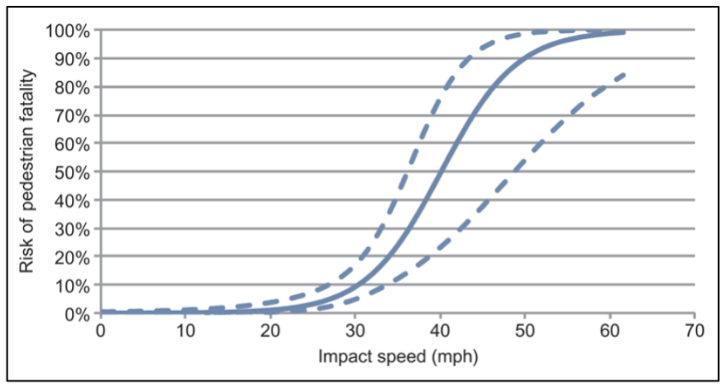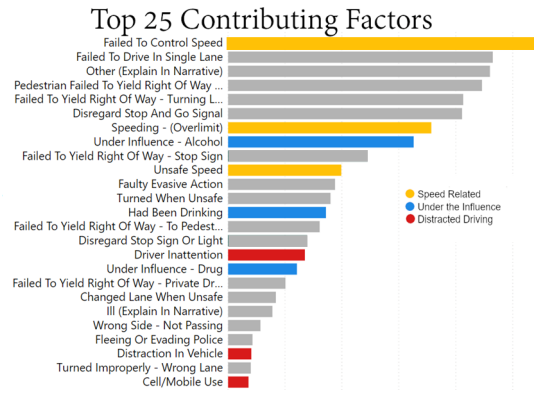Published by Brooker Law, PLLC — Dallas, Texas | Pedestrian Accident Lawyers
Last Updated: November 6, 2025
TL;DR
In Dallas, a few extra miles per hour can mean the difference between a broken bone and a funeral. Brooker Law, a Dallas-based wrongful death and catastrophic-injury firm, explains how speeding and driver inattention make crosswalks deadly, why physics—not fate—determines survival, and how victims and families can hold negligent drivers accountable under Texas law. Contact Brooker Law for a free, confidential consultation.
The Physics of a Fatal Difference
Every Dallas driver has felt the temptation -- the light’s turning yellow, you’re almost there, so you press the accelerator. That split-second decision can double the odds of killing someone in a crosswalk.
According to the Institute for Road Safety, a pedestrian hit at 20 mph has about a 95 percent chance of survival. At 30 mph, survival drops below 60 percent. At 40 mph, the odds of death climb above 80 percent.
Speed multiplies both impact energy and stopping distance. A car traveling 40 mph needs roughly 120 feet to stop—nearly half a downtown block. At 20 mph, it needs less than half that distance. That’s why so many severe Dallas crashes happen not on freeways, but on wide, high-traffic surface streets—roads like Loop 12, Ledbetter Drive, Buckner Boulevard, and Hampton Road—where speed feels safe until it isn’t.


When “Just a Little Over” Becomes Catastrophic
Many drivers underestimate how small speed increases change outcomes. In hundreds of Dallas police crash reports we’ve reviewed, phrases like “failed to control speed” or “unsafe speed for conditions” appear again and again. Those words are more than contributing factors. They’re legal fault indicators that juries take seriously.
Here’s what happens in real-world crashes:
- Reaction time stays the same, but at higher speed the car travels far more distance before braking even begins.
- Kinetic energy increases with the square of velocity—so a car at 40 mph hits with four times the force of a car at 20.
- Driver field of vision narrows as speed increases, meaning pedestrians aren’t even seen until it’s too late.
At Brooker Law, we’ve represented families who lost loved ones because a driver thought “five miles over” didn’t matter. It matters to the people in that crosswalk.

Why Dallas Crosswalks Are Especially Vulnerable
Dallas’s infrastructure amplifies the danger. Many intersections combine multiple lanes, long crossing distances, and permissive left-turn signals, forcing drivers to judge speed and direction in split seconds.
Vision Zero, which is studying pedestrian accidents in Dallas, has crash data that shows 27 percent of severe Dallas crashes are speed-related, and 62 percent of intersection crashes happen where a traffic signal is present. That means driver behavior and design interact negatively. The road design invites speed, and Dallas drivers readily accept the invitation. Failure to control speed is the leading contributing factor to severe crashes in Dallas, according to Vision Zero.

At night, glare from headlights and reflective paint adds another layer of risk. The city’s data confirms that most fatal pedestrian crashes occur just after sunset, when visibility and attention are at their weakest.
Legal Responsibility for Speeding Drivers
Under Texas Transportation Code § 545.351, every driver must control speed “as necessary to avoid colliding with another person or vehicle.” Failing to do so (whether or not the posted limit was exceeded) can constitute negligence per se.
In pedestrian cases, lawyers use speed evidence in the following ways:
- Skid-mark and vehicle-crush analysis to estimate velocity;
- Event Data Recorder (“black box”) downloads showing precise speed before impact;
- Expert reconstruction using distance, time, and momentum calculations; and
- Video evidence from cameras or nearby businesses to prove reaction time and braking distance.
Even a difference of five miles per hour can dramatically alter the outcome, and jurors understand that. When shown the expert's math, jurors see negligence.
Does It Matter If the Driver Was Only a Little Over the Limit?
Yes. Absolutely. Speed limits are not safe-speed guarantees. They’re maximums for ideal conditions. If visibility is poor, pedestrians are present, or the intersection is complex, a safe speed may be far below the posted limit. A driver who fails to slow down can still be found negligent, even if they weren’t technically “speeding.”
How We Try Speeding Cases
We combine our trial advocacy and expert accident reconstruction engineering to show juries what numbers can’t. With our experts, we paint a picture for the jury of exactly how the vehicles "go, stop, and turn" during the crash dynamics. Our team:
- Secures vehicle EDR data before it’s lost;
- Works with reconstruction experts to map impact angles, distances, and the road's geography;
- Obtains sequencing information for relevant traffic signals; and
- Obtains TxDOT and City of Dallas speed-study data for the exact corridor.
When jurors discover how speed turned a survivable collision into a fatal one, accountability for the defendant driver is sure to follow.
What To Do Now
Drivers:
- Slow down when approaching any crosswalk, even on green.
- Expect pedestrians at night and near transit stops.
- Remember that every 10 mph increase doubles stopping distance.
Pedestrians:
- Make eye contact with drivers before stepping off the curb.
- Use marked crossings when possible but know your rights outside them.
- Report broken signals or dark intersections to Dallas 311; small fixes save lives.
FAQ: Speed-Related Pedestrian Crashes
How can a lawyer prove the driver was speeding?
Through police or expert measurements, black-box data, video footage, and a formal accident reconstruction.
What if the driver wasn’t ticketed for speeding?
A traffic citation isn’t required for a civil claim. Your lawyer can still prove negligence through physical and digital evidence and expert testimony.
Can families bring a wrongful death claim for a speeding crash?
Yes. Surviving spouses, children, and parents may seek damages for loss of support, companionship, and mental anguish.
Are certain Dallas streets more dangerous?
Yes — Loop 12, Ledbetter, and Buckner Boulevard are frequent sites of speed-related fatalities. See our prior post concerning Where Dallas Pedestrian Crashes Happen The Most (and Why).
Contact Brooker Law
Brooker Law, PLLC represents victims and families in Dallas pedestrian accidents, crosswalk collisions, and wrongful death cases throughout Texas. Our firm’s mission is to make Dallas streets safer by holding negligent drivers and companies accountable. Contact Brooker Law today for a free, confidential consultation.
Disclaimer
This article is for informational purposes only and does not constitute legal advice. Every case is unique. For advice about your specific situation, contact Brooker Law, PLLC.











